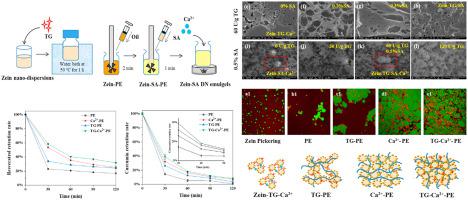当前位置:
X-MOL 学术
›
Food Hydrocoll.
›
论文详情
Our official English website, www.x-mol.net, welcomes your feedback! (Note: you will need to create a separate account there.)
Design and characterization of double-cross-linked emulsion gels using mixed biopolymers: Zein and sodium alginate
Food Hydrocolloids ( IF 11.0 ) Pub Date : 2021-04-01 , DOI: 10.1016/j.foodhyd.2020.106473 Jun Yan , Xiuping Liang , Cuicui Ma , David Julian McClements , Xuebo Liu , Fuguo Liu
Food Hydrocolloids ( IF 11.0 ) Pub Date : 2021-04-01 , DOI: 10.1016/j.foodhyd.2020.106473 Jun Yan , Xiuping Liang , Cuicui Ma , David Julian McClements , Xuebo Liu , Fuguo Liu

|
Abstract In this study, a double-cross-linked emulsion gel was formed using a Pickering emulsion as a template and two food-grade biopolymers, zein and sodium alginate (SA), as gelling agents. First, the zein was crosslinked with transglutaminase (TG) and then the alginate was crosslinked with calcium ions. The structure, interactions, and functional properties of the composite systems were then characterized using microscopy, infrared spectroscopy, and rheology measurements. These methods provided valuable insights into the formation mechanism of the double-cross-linked emulsion gels. The effects of single/double cross-linked emulsion gels on the photostability and bioaccessibility of co-loaded polyphenols (curcumin and resveratrol) were also compared. Our results show that SA concentration and TG activity impact emulsion gels stability and rheology. Single-cross-linked emulsion gels could be formed by only crosslinking SA (0.5 wt%) with calcium ions, but not by only crosslinking zein with TG. Double-cross-linked emulsion gels with dense network microstructures and high viscoelasticity were formed by using 60 U/g TG and 1.25 mM Ca2+ to crosslink the protein and polysaccharide, respectively. The single cross-linked emulsion gels improved the light stability and bioaccessibility of the two polyphenols, with the Ca2+-crosslinked system being more effective than the TG-crosslinked one. The double-cross-linked emulsion gels gave higher light stability and bioaccessibility than the single-cross-linked ones. Overall, this study shows that using a combination of TG and Ca2+ to crosslink the two biopolymers leads to edible composite materials with improved functional performance.
中文翻译:

使用混合生物聚合物的双交联乳液凝胶的设计和表征:玉米醇溶蛋白和海藻酸钠
摘要 在本研究中,以 Pickering 乳液为模板,玉米蛋白和海藻酸钠 (SA) 两种食品级生物聚合物为胶凝剂,制备了双交联乳液凝胶。首先,玉米蛋白与转谷氨酰胺酶 (TG) 交联,然后藻酸盐与钙离子交联。然后使用显微镜、红外光谱和流变学测量表征复合系统的结构、相互作用和功能特性。这些方法为双交联乳液凝胶的形成机制提供了有价值的见解。还比较了单/双交联乳液凝胶对共载多酚(姜黄素和白藜芦醇)的光稳定性和生物可及性的影响。我们的结果表明,SA 浓度和 TG 活性会影响乳液凝胶的稳定性和流变性。单交联乳液凝胶可以通过仅将 SA (0.5 wt%) 与钙离子交联来形成,而不能仅通过将玉米蛋白与 TG 交联来形成。通过使用60 U/g TG和1.25 mM Ca2+分别使蛋白质和多糖交联,形成具有致密网络微观结构和高粘弹性的双交联乳液凝胶。单一交联乳液凝胶提高了两种多酚的光稳定性和生物可及性,Ca2+ 交联体系比 TG 交联体系更有效。双交联乳液凝胶比单交联乳液凝胶具有更高的光稳定性和生物可及性。全面的,
更新日期:2021-04-01
中文翻译:

使用混合生物聚合物的双交联乳液凝胶的设计和表征:玉米醇溶蛋白和海藻酸钠
摘要 在本研究中,以 Pickering 乳液为模板,玉米蛋白和海藻酸钠 (SA) 两种食品级生物聚合物为胶凝剂,制备了双交联乳液凝胶。首先,玉米蛋白与转谷氨酰胺酶 (TG) 交联,然后藻酸盐与钙离子交联。然后使用显微镜、红外光谱和流变学测量表征复合系统的结构、相互作用和功能特性。这些方法为双交联乳液凝胶的形成机制提供了有价值的见解。还比较了单/双交联乳液凝胶对共载多酚(姜黄素和白藜芦醇)的光稳定性和生物可及性的影响。我们的结果表明,SA 浓度和 TG 活性会影响乳液凝胶的稳定性和流变性。单交联乳液凝胶可以通过仅将 SA (0.5 wt%) 与钙离子交联来形成,而不能仅通过将玉米蛋白与 TG 交联来形成。通过使用60 U/g TG和1.25 mM Ca2+分别使蛋白质和多糖交联,形成具有致密网络微观结构和高粘弹性的双交联乳液凝胶。单一交联乳液凝胶提高了两种多酚的光稳定性和生物可及性,Ca2+ 交联体系比 TG 交联体系更有效。双交联乳液凝胶比单交联乳液凝胶具有更高的光稳定性和生物可及性。全面的,











































 京公网安备 11010802027423号
京公网安备 11010802027423号